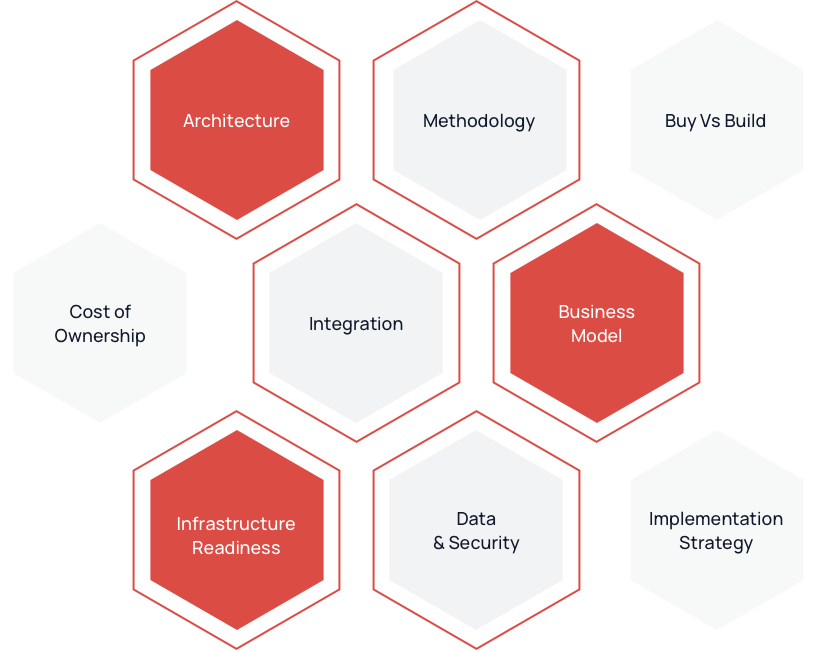Considerations:
Over the years businesses have grown and their growth was supported by their internal IT by
building/ procuring and deploying systems /applications. When these applications were
written, products were purchased, the single most focus was helping business on priority. Off-
course with organisations now moving on the path of Digital journey, Two Speed IT adoption
& drive through with continuous improvements through the loop back is very important. A
proper strategy to reduce the technical debt and in parallel work on new digital business model
is what most of the Organisations aim for and begin with. However the real challenges are
faced when business demands more rapid digitalisation than what is planned for / on-going
as due to the competition. This is were the pressure on the IT goes up significantly as they
have to deliver faster than what they have planned for. One has to evaluate various
components /elements/considerations of this strategy and adopt certain best practices to
increase the speed.

Figure 1.0: Different Elements which needs detail consideration
Reference figure 1.0, depicts the elements which need detail considerations and planning in
the Two Speed IT strategy with clear focus on the Digital.
Considerations and the evaluations of those:
Architecture: The digital architecture must be modular and Stable. The front end should be
dynamic and modular allowing rapid deployment of new services. The architecture should be
de-centralised (using microservices) with cross platform development. Do you have a Digital
Architecture and with right attributes ?
Business Model: It is important to understand the business model by the entire IT team in
the same way so that the digital services creation is aligned to serve the model. Companies
need to become skilled at digital-product innovation that meet growing business needs. Is this
the reality of your organisation ?
Methodology: Off-course the de-facto methodology will be agile, combined with DevOps/
DevSecOps. This requires proper segregation of platforms into domains managed for efficient
delivery or for transactional integrity. Have you adopted agile and has it made difference to
your speed to delivery ?
Integration: There needs to be selection of correct tools for integration as it may be Hybrid
architecture with legacy – systems of Record around there and at the same time modern tech
front end talking to it via integration tools. Inefficient system integration and slow database
access time can prevent the customer from enjoying a seamless user experience. Many
organisations have lagged behind in the Digital journey due to absence of Integration strategy.
Infrastructure Readiness: Infrastructure is the key factor influencing the digital journey. With
legacy and digital systems co-existing there has to be proper focus on the planning and
implementation of the underlying Infra. Workload increases with time and becomes hard to
predict in the digital business world. This load should be balanced across various cloud
environments with efficient optimization, so if one of the environments has an outage the
others can compensate for the load. For modernisation too right Infrastructure is needed. Do
you have one ?
Data and Security: Having a right data strategy for building the single source of truth is critical
to the data strategy. With multiple Data sources spread across and data operations also
become complex. The Data which was stored in the legacy and was very much secure and
protected as it was not accessible to end user directly. Now with customer experience focus
this data is being exposed to the external world creating a threat to data security and privacy.
Cybersecurity must be an integral part of the overall service/product, as the company has
valuable data to protect, making it prone to attackers.
Implementation Strategy, Buy Vs Build, Cost of Ownership are other three considerations
which are critical to focus upon. It is important to decide upon how the IT Portfolio – existing
will be modernised and what new will be built. What will be developed ground up Vs what will
be brought as a product. We @Betacraft have a 6R™ methodology which simplifies these
actions, and makes decision making easy. Cost of ownership also need to be defined,
baselined and budgeted to run the initiatives without any interruption.
Some of the Best Practices which one can adopt to drive the speed@digital journey:
- Ensure Change Management Workshops across business and IT are conducted
sharing the vision and roadmap - Encourage and Reward collaboration
- Allow failures and encourage risk taking
- Define the business problem being solved and measures of the success
- Every quarter share with all the achievements, failures, business impact achieved
- A strong governance with clear KPIs to track is very important
Finally IT Leadership have to really drive this journey as all inclusive with collaboration as the
key mantra and all aligned to the same goals/ objectives.
